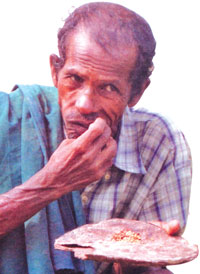 Gobindapur, Siraha-Jagbir Sada, 55, is sitting outside his house chewing on dry millet roti. He explains to us that this is what poor people eat in that region. "Our landlords would never eat this," he says. His landlord's concrete house stands next to his hut. The graffiti by Janatantrik Tarai Mukti Morcha (JTMM) on the walls of the landlord's house reads: 'Nepali rulers, get out of the tarai'. But groups like JTMM have never fought for the poor people of the tarai because they are into abduction, ransom, arson and spreading terror. They haven't even thought about the feudal system of landlord, girhat, and agricultural labourers, haliya, they use almost like slaves.
Gobindapur, Siraha-Jagbir Sada, 55, is sitting outside his house chewing on dry millet roti. He explains to us that this is what poor people eat in that region. "Our landlords would never eat this," he says. His landlord's concrete house stands next to his hut. The graffiti by Janatantrik Tarai Mukti Morcha (JTMM) on the walls of the landlord's house reads: 'Nepali rulers, get out of the tarai'. But groups like JTMM have never fought for the poor people of the tarai because they are into abduction, ransom, arson and spreading terror. They haven't even thought about the feudal system of landlord, girhat, and agricultural labourers, haliya, they use almost like slaves.
Sada, father of three sons and nine daughters, tills the girhat's land for a living. But the Sada family never have enough to eat. He works in the fields all day, every day and gets 4kg worth of rice (Rs 40) a day from the landlord. Sada knows that if he were earning wages, he would be making more. He has no alternative but to work for the landlord because he does not have his own land, or the means to go and look for another job.
The Madhes Uprising in January last year was against the discrimination of the madhesi people by the state. This tradition of girhat-haliya has been present in Nepal for centuries, yet the uprising and leaders haven't addressed this issue at all. Almost a year after the movement, it is now clear that the Madhes Uprising was more about getting rid of the Maoists from the tarai than about fighting for the rights of madhesis. It was just an expression of anger of the middle-class madhesis against the Maoists in the region. The uprising saw the participation of the poorest people in the region but the suppression of these people by the rich remains.
Biltu Sada, 35, of Malhanuwa, tills Ram Lakhan Raya's land. Sada took over from his father because his father could not work the fields any more. The Sada family has to pay off debt to the landlord at five percent interest per year. "The landlord keeps all the accounts, we probably have a lot more to pay off," says Biltu. Their landlord gives them a small piece of land to till, but they can only do that after Raya's land has been cultivated. They have no water to irrigate and no money to buy fertiliser, so the little rice they get from their part of the field is never enough for the family. "I am bound to the landlord by debt. There's no way out: if I run and am found, the landlord will beat me to death," says Sada.
Kathmandu talks about inclusiveness and a new Nepal, but in the tarai the medieval feudal system persists. The landlords prohibit the labourers' children from going to school because they need more hands to work the field. Sometimes the landlord pays out his own money for members of the haliya's family to go abroad, then takes all the money they earn from there and loans it out to labourers at a very high interest rate.
Bisheswor Yadav, a landlord in Gobindapur, says:"Farmers like us have our own problems. The government needs to give us some facilities. If we do not have these agricultural labourers, we cannot cultivate," Yadav says.
When the bonded labourers (kamaiya) were freed, the landowners also should have let go of the haliya. Jana Andolan II came and went, the Madhes Uprising is over, and it is now clear that those movements were about giving the madhesi middle-class the opportunity to join in Kathmandu politics. Looking back at the Madhes Uprising one year on, anyone can see it was successful in sidelining the Maoists but an utter failure in fighting for the rights of the poor in the tarai.
Madhav Dhungel


